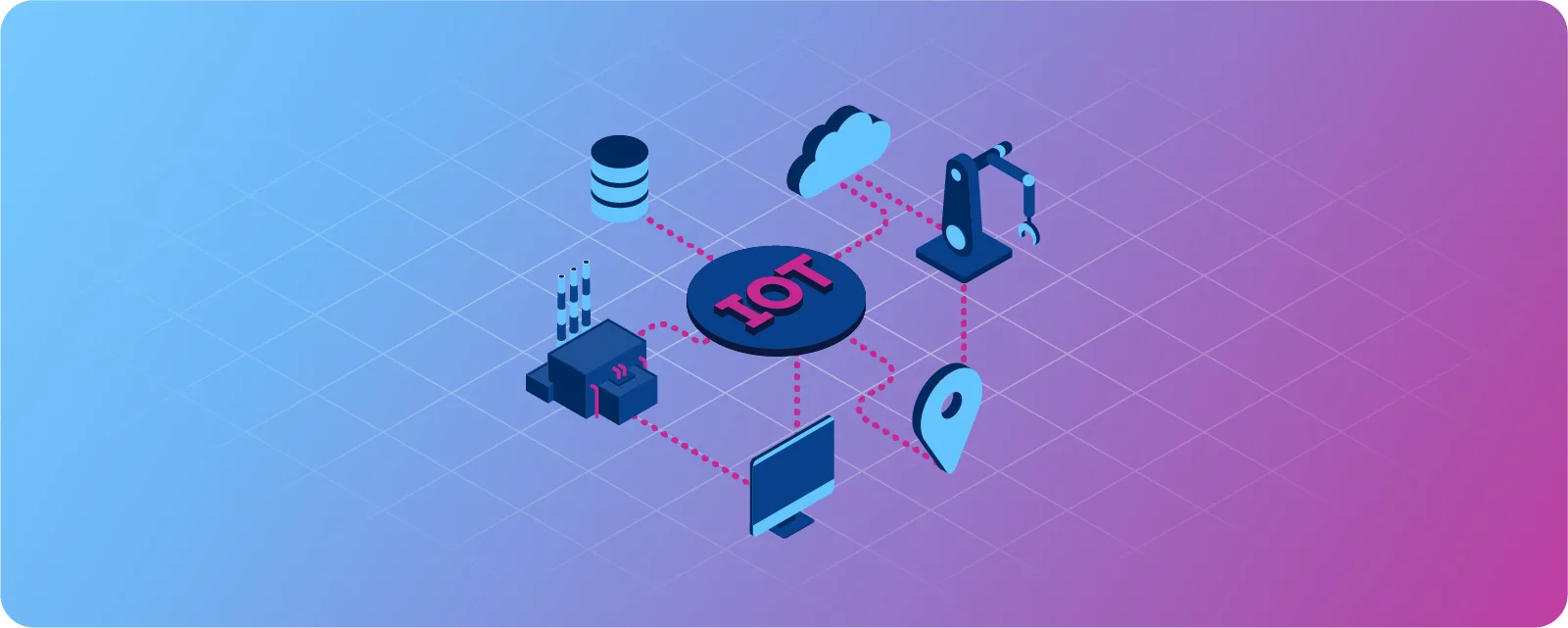Key takeaways
- IoT integration transforms disconnected device data into business intelligence across industries.
- Robust collection, storage, analytics, and visualization systems work together for effective integration.
- Hybrid approaches combining real-time stream and batch processing deliver comprehensive IoT insights.
- Industries use IoT integration for predictive maintenance, fleet tracking, and operational efficiency.
Introduction
Picture this: your global business is surrounded by smarter technology every day. That’s the IoT revolution: millions of devices doing their jobs and sending back useful data.
And it’s growing fast. 16.6 billion devices in 2025, heading towards 40 billion by 2030, according to IoT Analytics.
But here’s the catch: without integration, all that data stays scattered. It’s like having agents in the field with no way to report back.
IoT data integration is your command center, turning ordinary objects into smart tools that collect and share valuable data. When done right, it’s like having a well-oiled machine where every part knows exactly what the others are doing, leading to smarter automation and better decision-making across your entire operation.
💡 Use accurate location data for IoT data integrations. For over 15 years, we have created the most comprehensive worldwide zip code database. Browse GeoPostcodes datasets and download a free sample here.
Key concepts
Understanding the basics of IoT technology gives you the foundation to unlock its full potential in business operations, data integration, and real-world applications. Let’s explore one by one.
What is IoT?
Think of Internet of Things (IoT) as your physical world going online. It’s a vast network of devices embedded with sensors, software, and connectivity that enables them to collect and exchange data over the Internet.
Industrial machines that report their own wear and tear, shipping containers that track their location in real time, and medical devices that alert staff before something goes wrong… You name it. If they can collect data, they can be part of the IoT ecosystem.
In a business setting, IoT becomes even more powerful. It spans everything from smart manufacturing lines that adjust automatically, to asset tracking tools that eliminate guesswork, to environmental sensors keeping tabs on conditions across global operations.
Each device is feeding insights directly into your systems. The more connected your tools are, the smarter your operations become.
The Essence of IoT Data Integration
IoT devices worldwide generate data, but without integration, that data sits there in silos, disconnected and underutilized.
Integration changes that. It collects data from all sensors and platforms, cleans it up, standardizes it, and routes it into your existing systems like ERP, analytics dashboards, etc. You will have seamless workflows, real-time visibility, and fact-based decisions.
This creates a constantly updating single source of truth across operations, transforming scattered signals into strategic insights—your competitive edge.
Business Applications: How Organizations Leverage IoT Data Integration
Organizations across various industries are utilizing the power of IoT data integration to transform their operations. Understanding these real-world applications can help you identify opportunities within your own business context.
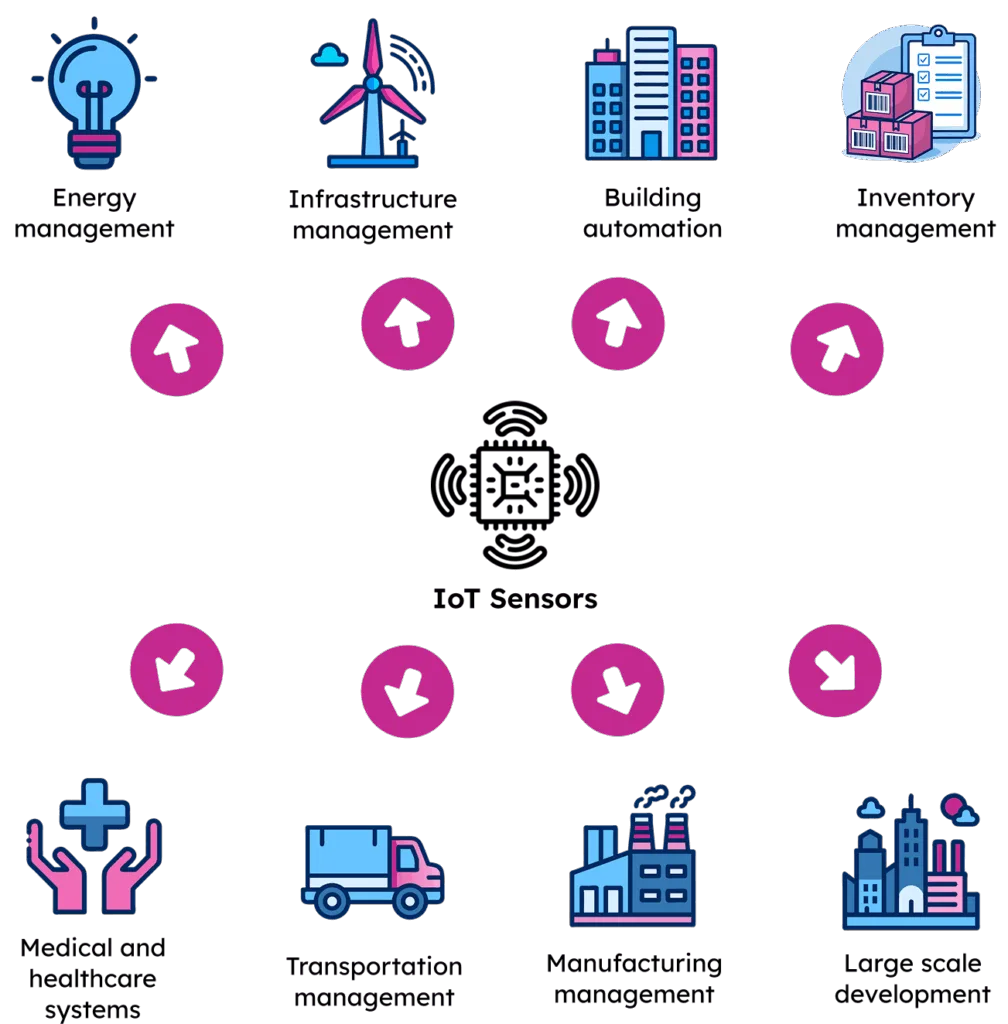
Fleet Management and Logistics
For logistics, with telematics solutions powered by IoT, you’re no longer just tracking vehicles; you’re watching them move in real time, monitoring how they’re driven, and optimizing routes for enhanced efficiency.
For example, DHL uses IoT sensors to monitor the health and performance of its fleet. By incorporating IoT sensors into vehicles, the company’s operators receive data that allows them to predict when components or systems in their fleet require maintenance. This helps managers make timely interventions, prevent unexpected breakdowns, and decrease maintenance costs.
Integration synchronizes everything: location data triggers automated dispatching, routes update with traffic and weather, and vehicle telemetry enables proactive maintenance. The result? Fewer delays, lower fuel costs, and improved efficiency from warehouse to delivery.
Supply Chain and Inventory Management
Amazon implemented an IoT-based warehouse management system in its fulfillment centers to track the movement of packages and automate inventory flow. Walmart worked with Symbotic to bring high-tech automation to its supply chain. They adopted mobile bots and complex algorithms to optimize storage and retrieval processes, speed up inventory handling, improve accuracy, and customize pallets for efficient unloading.
Without IoT integration, supply chains running on manual updates are flying blind. With it, assets, shipments, and shelves create a live feed. Embedded sensors provide real-time stock levels, demand patterns, and movement tracking.
Smart Facilities and Energy Management
Now shift that lens to your buildings. Forward-thinking companies use IoT to turn their facilities into energy-efficient masterpieces. Occupancy sensors adjust lighting and temperature automatically, helping you reduce operational costs and achieve sustainability goals effortlessly.
Connecting these systems to your central platform gives you comprehensive energy visibility across all facilities, with optimization capabilities from a single dashboard.
Predictive Maintenance in Manufacturing
General Electric (GE) has integrated AI-based predictive maintenance into its manufacturing processes, using AI to monitor and analyze the performance of engines and turbines. With AI, GE can predict engine component failures, reducing unplanned maintenance by 30% (Process Genius), cutting repair costs, and improving asset reliability.
According to Emerj AI Research, between 2025 and 2025, GE constructed over 1.2 million digital twins, generating around $600 billion for the company and its customers. GE Vernova‘s SmartSignal uses AI-powered digital twins to predict equipment issues. Trusted by top energy companies, it monitors over 7,000 assets globally and has saved customers over $1.6 billion.
In manufacturing, with IoT sensors integrated into your maintenance systems, machines start warning you before something goes wrong. They send up a digital flare: “Hey, this bearing’s about to fail. Schedule me in.”
Healthcare Monitoring and Management
According to Forbes, in 2025, the IoT healthcare market is predicted to grow to around $150 billion, with an expected $289 billion by 2028. In healthcare settings, IoT is about real-time, life-impacting information. Remote monitors, wearable devices, and smart medical equipment generate nonstop streams of vital data.
When that data gets integrated, patient vitals flow directly into EHR (Electronic Health Records) systems and decision-support tools. Doctors see problems before symptoms even surface. Care teams respond faster. Patients get more personalized, data-driven treatment without the endless guesswork.
Key Components of Effective IoT Data Integration
Successful IoT data integration requires several key components working together to keep data moving and decisions flowing. Let’s break down what makes IoT integration tick.
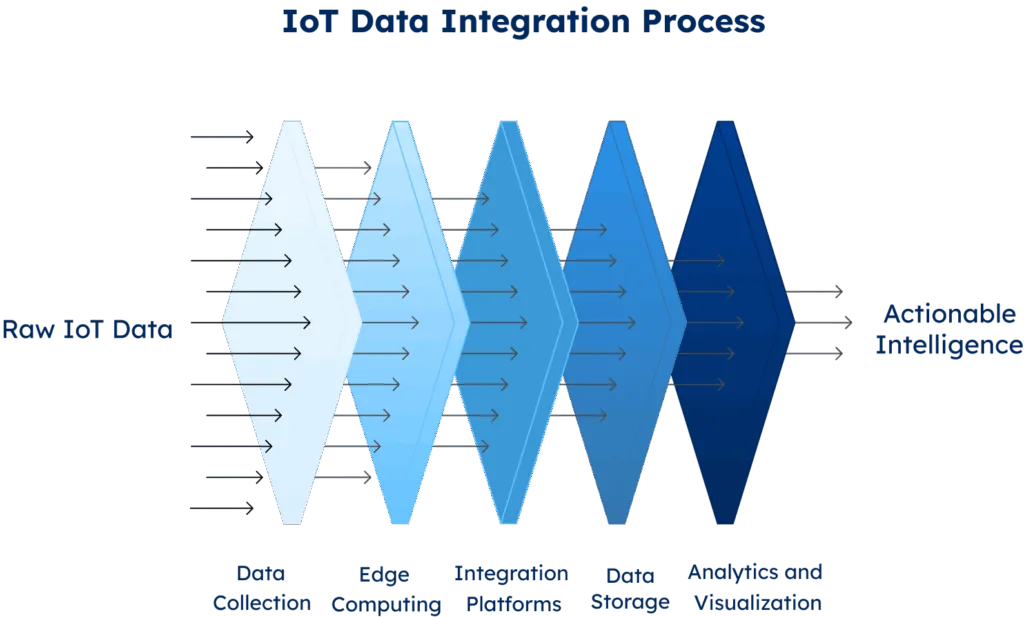
Data Collection and Processing
Data collection is your foundation. This involves capturing data from various IoT devices and sensors, cleaning and normalizing it, and preparing it for integration with other systems like Enterprise Resource Planning (ERP) systems, Customer Relationship Management (CRM) platforms, Manufacturing Execution Systems (MES), Warehouse Management Systems (WMS), Business Intelligence (BI) dashboards, and Electronic Health Record (EHR) systems.
Edge Computing
Edge computing is a distributed computing approach that brings data processing and storage closer to the source of data. It acts like a smart filter, processing data right at the source to ensure only the most relevant information makes it to your central systems.
Integration Platforms and Middleware
Next, you need something to glue it all together, and that’s where integration platforms and middleware come in. They are the translators, air traffic controllers, and automation engines of your IoT setup.
If your IoT devices speak ten different languages, enterprise iPaaS platforms (Enterprise Integration Platform as a Service, a cloud-based solution that helps businesses integrate and connect their applications, systems, and data sources) make sure they’re all understood by your ERP, CRM, and analytics systems. They come with pre-built connectors, data mapping, and workflow tools that save you from the chaos of custom code.
Data Storage and Management
IoT sensors stream updates by the second. With IoT devices generating data faster than a newsroom on election night, you need robust storage solutions that can handle the flood.
Time-series databases are perfect for this job. They’re designed specifically to handle the constant stream of timestamped data that IoT sensors produce. They’re like highly organized librarians who know exactly where to file each piece of information and can retrieve it instantly.
Analytics and Visualization Tools
Now that your data’s stored and organized, what can you do with it?
Your data needs to transform from raw numbers into actionable intelligence. Modern analytics and visualization tools (such as Tableau, Power BI, Grafana, Looker, and QlikView) take millions of data points and predict trends that could make or break your business decisions.
Also, machine learning and modeling help you forecast outcomes, identify issues, and spot hidden patterns.
The Challenges of IoT Data Integration
Despite the numerous benefits of IoT data integration, you’ll still need to clear several hurdles when implementing your strategies.
Volume and Variety of Data
IDC forecasts that IoT devices will generate an estimated 79.4 zettabytes annually by 2025. It’s a tsunami. Also, each device speaks its own language and has unstructured formats, making it crucial to have systems that ingest, normalize, and make sense of wildly different data types.
Data Unification and Standardization
When your IoT stack includes hardware from multiple vendors, software from different eras, and communication protocols that don’t play nice together, the integrated data gets messy. To get ahead of this, you need a reliable broker to provide data in a consistent data format.
Scalability and Performance
The strain on network resources, storage, and databases grows with your IoT network. You need to plan for increased traffic, better processing power, and infrastructure without disrupting the day-to-day operations and performance.
Security and Privacy Concerns
Each connected device represents a potential entry point for unauthorized access. A misconfigured sensor can lead to privacy risk, especially when sensitive or regulated data is involved.
That’s why IoT integration demands layered defenses. They include secure device provisioning, end-to-end encryption, strong authentication, and systems that detect weird activity immediately.
Strategies to Overcome IoT Data Integration Challenges
Let’s roll up our sleeves and tackle those IoT integration challenges head-on. You will know the battle-tested strategies that’ll help you turn your IoT data from a wild beast into a well-trained asset.
Develop a Comprehensive Data Integration Strategy
Before wiring up devices across global sites, map out what you have: your current data sources, systems, and equipment that gather data. Then, identify what you’ll need down the road. By identifying every touchpoint in your data pipeline, you can create a centralized and coherent strategy.
Your governance framework must address data collection, ownership, quality standards, access controls, and cross-border compliance. This transforms good intentions into scalable, secure, long-term solutions.
Establish Data Quality Standards
In the world of IoT, where machines talk nonstop, use data integrity and data quality as your filter to ensure only reliable information enters your systems. Your team should create clear quality standards. They’ll define how data should look, how it should flow, and what makes it “good enough” to enter your system.
Set up automated quality checkpoints throughout your data pipeline to ensure consistent quality. This way, only the cream of the crop makes it to your analysis and decision-making processes.
Use Modern Integration Platforms
Today’s integration platforms (iPaaS) like MuleSoft, Boomi, Informatica, and Tray.io come packed with pre-built connectors, edge computing capabilities, and cloud-native scalability. They also help bridge the gap between devices and enterprise systems, without writing mountains of custom code. Less friction, faster deployment, and a much smoother path to insight.
Start to use it, so you can stop reinventing the wheel and start solving real problems.
Adopt Standardized Communication Protocols
Think of protocols as the diplomatic language of IoT. When everything speaks the same language, whether it’s MQTT for quick messages, CoAP for simpler devices, or HTTP/REST for web interactions, your whole system just works better together.
Pick the right protocol for the job, and you’ll save yourself hours of troubleshooting and avoid the mess of custom interfaces.
Implement Robust Security Measures
More connected devices = more entry points. And if your integration strategy doesn’t include solid security, you’re building a smart system with an open door.
Security can’t be bolted on later. You need strong device authentication, encryption, access controls, and continuous monitoring baked into your stack from day one. And with real-time threat detection, you’re not waiting for an audit for problems. You’re stopping breaches before they start.
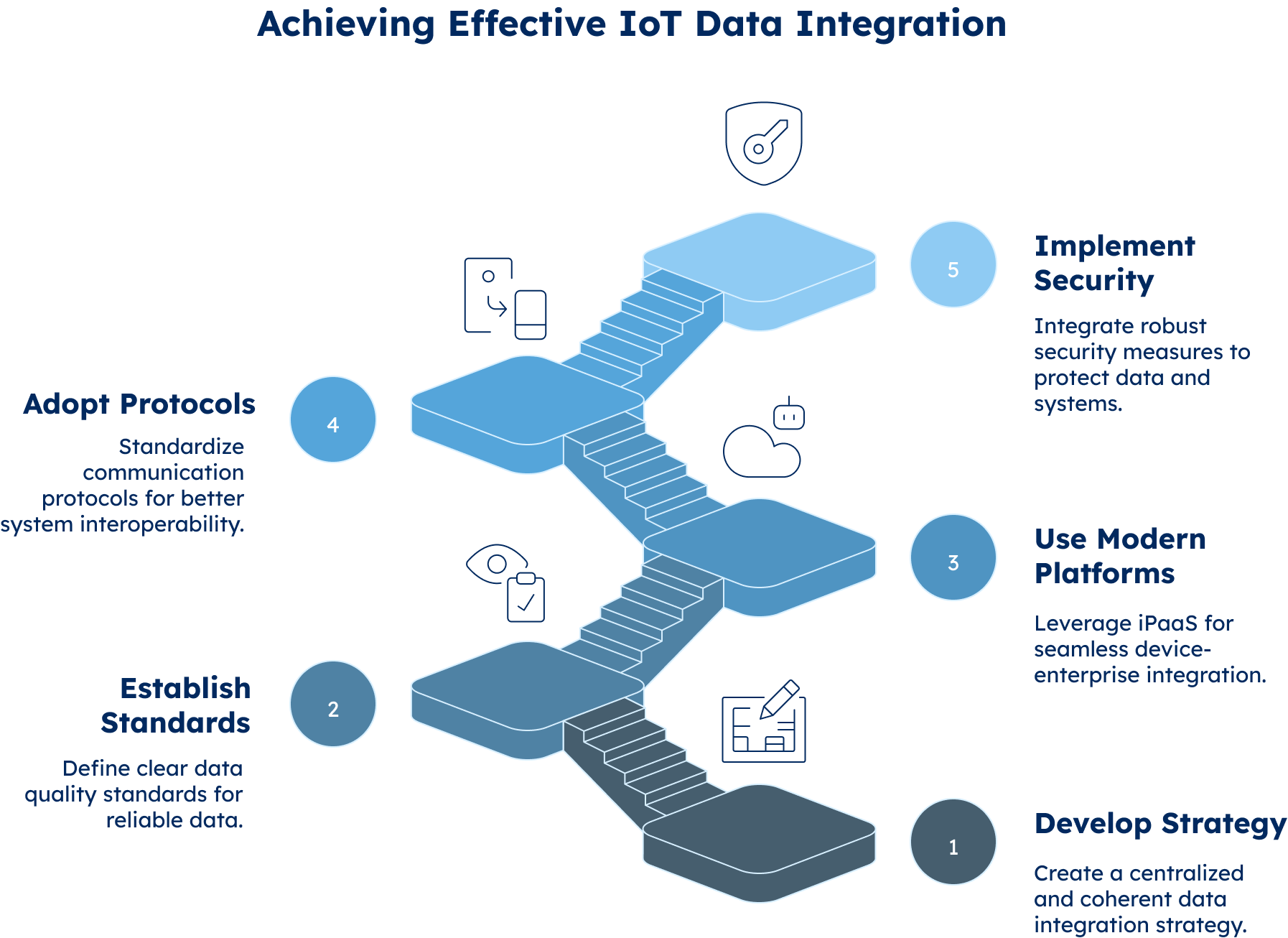
Old School vs. New School: How We Handle IoT Data
IoT moves really fast. Your data doesn’t trickle in, it streams in. Let’s talk about how we’re leveling up the game when it comes to handling all that IoT data flowing through your business.
The Old Way: Batch Processing
Legacy integration tools run on scheduled jobs, pulling data every hour and every night. That might’ve worked for ERP reports and static databases, but not in today’s IoT world.
When machines generate thousands of data points per minute, waiting for the next batch job can be a bottleneck. For predictive maintenance, fleet tracking, or real-time inventory, you need decisions made in seconds.
Also, batch systems aren’t exactly known for being nimble. As your device count grows, so does the stress on your systems. Scaling becomes clunky, costly, and brittle.
The New Way: Stream Processing for Real-Time Magic
Now contrast that with modern stream processing. This is real-time insights, always-on data handling. Platforms like Apache Kafka, Apache Flink, and cloud-native services are built to ingest, process, and route live data as it’s created.
Whether rerouting deliveries, preventing equipment failures, or updating dashboards instantly, stream processing delivers immediate insights and scales effortlessly with your IoT needs, eliminating job windows and database bottlenecks.
Getting the Best of Both Worlds: The Hybrid Approach
Stream processing is great for real-time data. Batch processing handles historical data analysis like a pro. A hybrid approach gives you both: fast insights and deep context.
Modern platforms support both workflows under one roof, so you can process urgent operational data in real-time while running deeper analytics on historical trends.
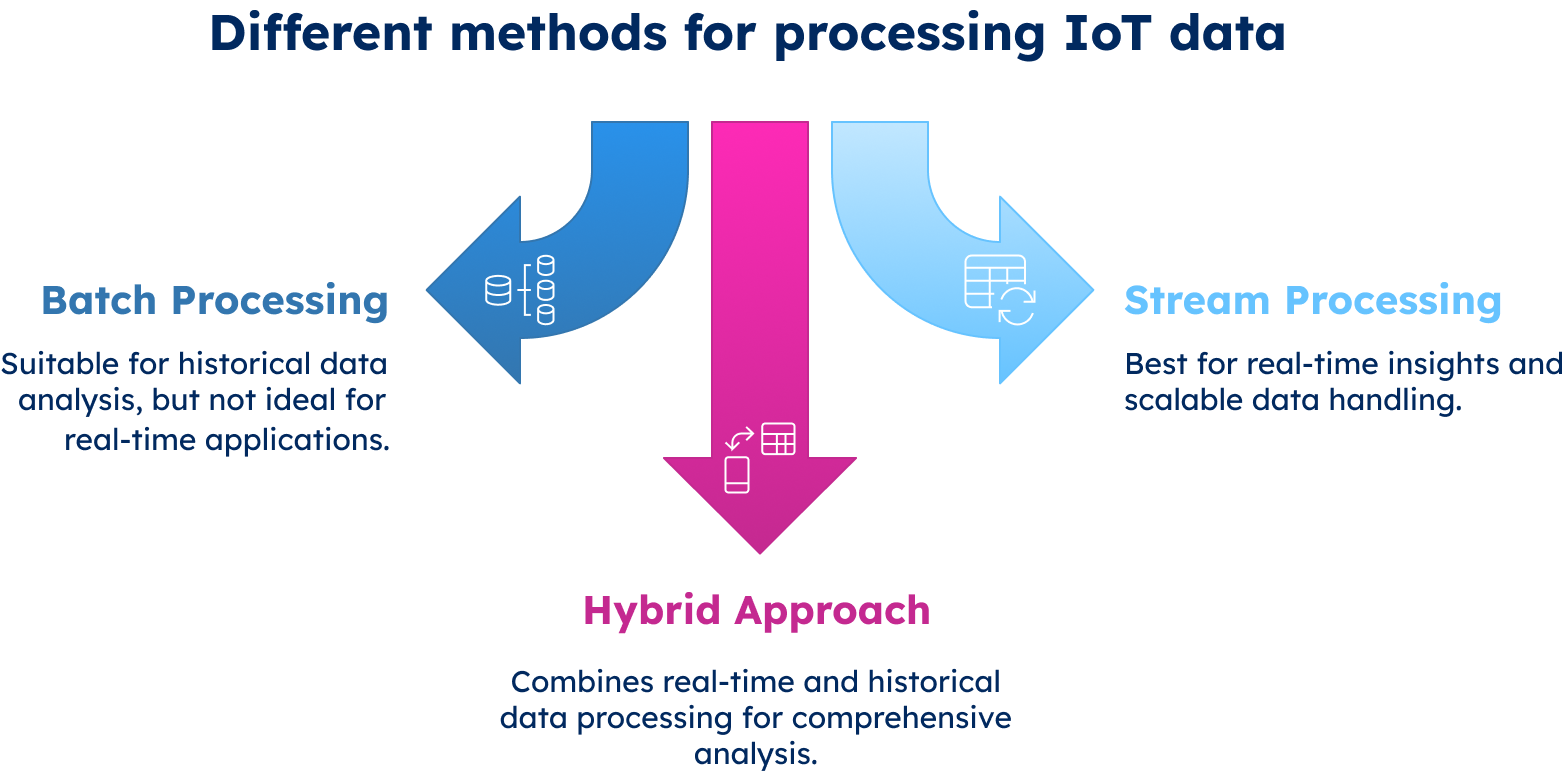
Conclusion
IoT data integration connects smart devices with business systems. It delivers actionable insights, faster decisions, and smoother operations. Despite challenges of data volume, compatibility, and security, the right strategy makes these manageable.
As IoT expands, effective integration separates data collectors from industry leaders. A thoughtful approach turns IoT investments into business advantages, creating smarter, more connected operations.
We invite you to browse our databases for free to explore how our comprehensive location data can enhance your IoT integration efforts. For over 15 years, GeoPostcodes has maintained accurate and up-to-date location data that forms the foundation for successful integration projects. Contact us or request a quote for any assistance you might need in leveraging location data for your IoT initiatives.
FAQ
What is IoT data integration?
IoT data integration connects IoT sensors, outdated systems, and multiple sources to eliminate data silos. It enables real-time analytics, business growth, and improved operational efficiency across all your data.
What are the 4 types of IoT?
The four types are consumer, commercial, industrial, and infrastructure IoT. They are used for remote monitoring, customer engagement, risk management, and digital transformation with seamless connectivity and real-time data integration.
What are examples of data integration?
Examples include integrating legacy systems, remote monitoring tools, and new IoT devices. They aim to streamline workflows, predict maintenance, and support complex data needs for seamless communication and business operations.
What is IoT data processing?
IoT data processing analyzes complex data from IoT sensors in real time. It enables sensitive data handling, improved operational efficiency, and the necessary infrastructure to support business operations and customer engagement.
